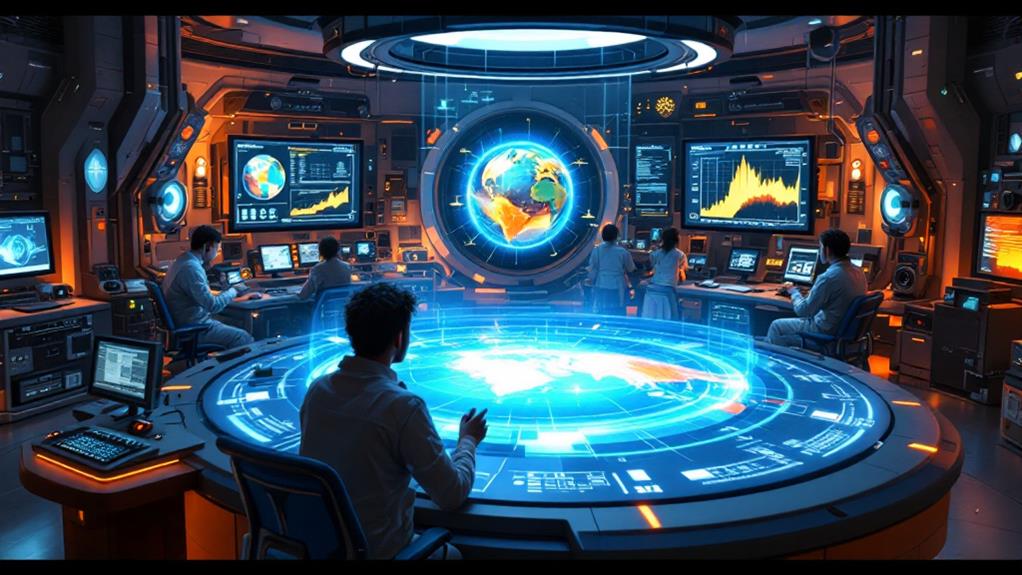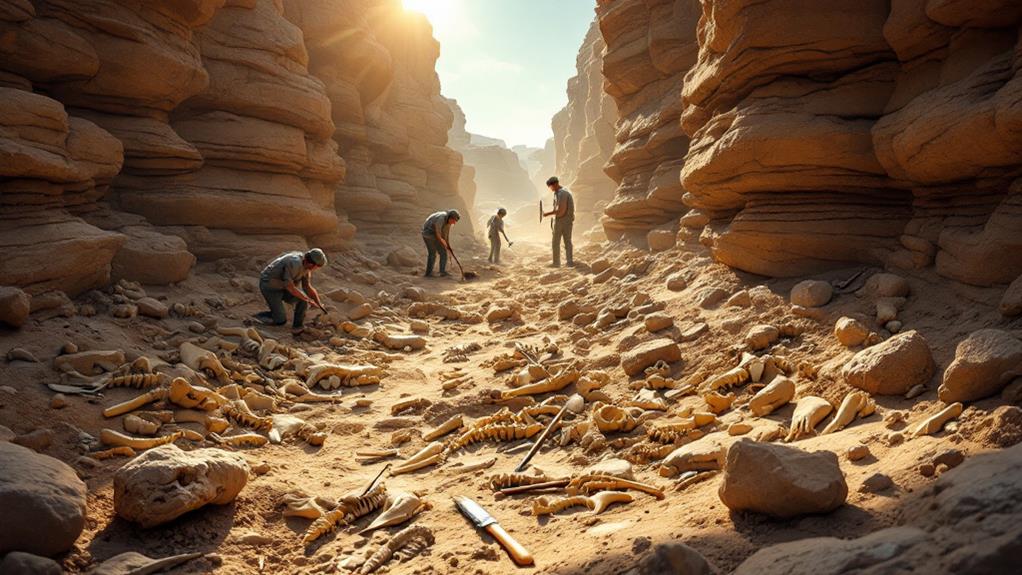The History of Seismology: Studying Earthquakes and Their Impact

You're about to immerse yourself in the intriguing history of seismology, where beliefs about divine wrath gave way to scientific inquiry. Early thinkers like Aristotle proposed natural causes, challenging myths. Seismology truly evolved with John Michell's wave theory, while the 1755 Lisbon earthquake spurred deeper investigation. Cutting-edge seismographs eventually emerged, allowing for major 20th-century breakthroughs like Inge Lehmann's revelation of Earth's solid inner core. The theory of plate tectonics furthered our understanding of earthquake mechanics. Today, seismology integrates advanced technology for predictive insights and safety improvements. As you investigate, you'll uncover how this field has profoundly shaped our world.
Ancient Interpretations of Earthquakes
Throughout history, interpreting earthquakes has fascinated and puzzled many cultures. When you investigate ancient interpretations, you'll find a rich tapestry of mythical explanations and religious interpretations. Many cultures believed that earthquakes were the result of displeased gods or mythical creatures. These beliefs were deeply rooted in the social beliefs of the time, shaping the way communities responded to such natural events.
Cultural responses to earthquakes often included rituals or offerings meant to appease these deities. Historical records and ancient texts provide insight into how societies tried to make sense of the earth's tremors. For instance, the ancient Greeks attributed earthquakes to the wrath of Poseidon, the god of the sea. Likewise, in Japan, the Namazu, a giant catfish, was thought to cause earthquakes with its thrashing.
While mythical explanations dominated, some early geological observations hinted at a more natural cause. Ancient scholars occasionally included philosophical reflections about the earth's movements, pondering the possibility of natural forces at work. Despite their limitations, these early interpretations laid the groundwork for future explorations into the causes of earthquakes, as societies sought to understand the balance between divine influence and natural phenomena.
Early Philosophical Theories
The change from mythical to philosophical understanding of earthquakes marked a vital shift in human thought. No longer were these natural phenomena solely attributed to wrathful gods or mythological interpretations. Instead, thinkers began to seek more rational explanations. Aristotelian explanations played a significant role in this transformation. Aristotle proposed that winds trapped within the Earth caused tremors, an idea that sparked philosophical debates and influenced medieval beliefs.
You might find it fascinating how these early thinkers sought to rationalize what was once shrouded in superstition. They didn't have modern tools, but they used observation and reasoning to challenge prevailing myths. Their efforts laid groundwork for a more scientific approach to understanding the Earth.
During the medieval period, these Aristotelian explanations blended with religious views, creating a tapestry of ideas that tried to harmonize science and belief. Earthquakes were still seen as divine signs, but the quest for natural explanations persisted. This time of philosophical debates was significant, as it showed a growing desire to understand the world through reason. By questioning mythological interpretations, these early philosophers paved the way for future scientific inquiry.
The Birth of Seismology

With the dawn of the modern period, curiosity about earthquakes evolved into a structured field of study we now call seismology. You begin to see a transformation as historical figures take center stage, shaping the way we comprehend seismic events. The 18th and 19th centuries marked significant milestones. One of the crucial figures was John Michell, an English natural philosopher, who initially suggested that earthquakes are waves traveling through the Earth. This insight laid the groundwork for future exploration.
As you explore deeper, you notice the role of significant seismic events in propelling the study of seismology. The Lisbon earthquake of 1755, for instance, was a catalyst. Its massive impact prompted scholars to seek scientific explanations and comprehension beyond religious interpretations.
Consider these key developments:
- John Michell's Hypothesis: He proposed that earthquakes are caused by shifting masses within the Earth.
- Lisbon Earthquake: This catastrophic event highlighted the need for scientific inquiry.
- Global Interest: Rising interest led to international collaborations, advancing the field further.
Seismographs and Instruments
Seismographs transformed the study of earthquakes by providing tangible data on seismic activity. As you delve into the fascinating world of seismographs, you'll uncover how these instruments evolved over time. Early seismographs were rudimentary, using pendulums and levers to amplify ground motions. Despite their simplicity, they marked the beginning of a new age in understanding earthquakes.
As technology advanced, the seismograph evolution continued, leading to more precise and sensitive instruments. Modern seismographs use electronic sensors and digital recording to capture seismic waves with remarkable accuracy. These advancements allow you to analyze not just the strength of an earthquake, but also its depth and location.
However, to guarantee these instruments provide reliable data, instrument calibration is vital. Calibration involves adjusting and testing the seismograph to confirm it accurately records seismic events. Without proper calibration, the data collected could be misleading, affecting your understanding of an earthquake's behavior.
Major 20th Century Discoveries

Imagine revealing secrets concealed deep within the Earth's crust—this was the reality for seismologists in the 20th century. You'd find yourself delving into a world of seismic waves, which transformed our understanding of earthquake patterns. The 20th century heralded breakthroughs that reshaped how we perceive our planet's dynamic nature.
- Revelation of Earth's Inner Core: In 1936, Inge Lehmann, a Danish seismologist, interpreted seismic waves to reveal the existence of Earth's solid inner core, situated beneath the liquid outer core. This revelation was essential in understanding Earth's structure.
- Seismic Wave Propagation: Advancements in technology allowed you to observe how seismic waves traveled through different layers of Earth, leading to the identification of numerous wave types, such as P-waves and S-waves. These insights were vital for mapping Earth's interior.
- Earthquake Patterns Analysis: By studying seismic data, you could identify recurring earthquake patterns and understanding these patterns enabled better prediction models and risk assessments, enhancing public safety.
These revelations laid the groundwork for modern seismology, offering you a clearer picture of the Earth's inner workings. With each finding, the 20th century brought you closer to unraveling the mysteries concealed beneath our feet.
Plate Tectonics Revolution
Unraveling the mysteries of Earth's surface dynamics, the plate tectonics revolution of the mid-20th century transformed how you understand the planet's ever-shifting crust. Before this groundbreaking period, the concept of continental drift was a puzzle many couldn't quite piece together. But as researchers began to recognize the significance of tectonic plates, it became clear that these massive slabs of Earth's crust move and interact in complex ways.
By examining tectonic boundaries, you can see where these plates converge, separate, or slide past one another, leading to varied geological processes. Earthquakes often occur near these boundaries, where the strain from crustal deformation is most intense. As plates grind against each other along fault lines, they release energy in the form of seismic waves, shaking the surface above.
Understanding earthquake mechanics became more accessible once the movement of tectonic plates was established. By linking these processes, you gain insight into how and why earthquakes occur. The plate tectonics revolution didn't just redefine the study of Earth's structure; it also provided a framework for predicting the behavior of fault lines and improving our comprehension of seismic activity.
Advances in Earthquake Prediction

Building on the foundation laid by the plate tectonics revolution, advances in earthquake prediction have come a long way, offering hope for minimizing disaster impacts. You're now seeing exciting developments through a combination of technological innovations and sophisticated techniques. Machine learning plays an essential role, analyzing vast amounts of historical data to identify patterns that might indicate an impending earthquake. By incorporating statistical methods, researchers improve the accuracy of predictive modeling, aiming to provide more reliable forecasts.
Here's how these advancements impact earthquake prediction:
- Real-Time Monitoring: Cutting-edge sensors and networks deliver data instantaneously, enhancing early warning systems and allowing for faster response times.
- Risk Assessment: By evaluating potential earthquake scenarios, communities can better understand their vulnerabilities, leading to effective mitigation strategies.
- Community Preparedness: With improved prediction accuracy, individuals and local governments can devise plans and conduct drills, ensuring readiness when an earthquake strikes.
These innovations don't just help in predicting earthquakes; they empower communities to act proactively. While perfect prediction remains elusive, these advances bring us closer to a future where the impacts of earthquakes could be greatly reduced, helping save lives and protect infrastructure.
Societal Impacts of Earthquakes
Experiencing an earthquake can profoundly affect communities, reshaping their social and economic landscapes. You might notice how disaster preparedness becomes a priority, as communities endeavor to minimize damage and protect lives. Yet, even with the best plans, the psychological effects are unavoidable. Anxiety and trauma can linger long after the ground stops shaking, impacting daily life and mental health.
Economic recovery is another hurdle. Local businesses may struggle to reopen, while insurance implications add layers of complexity. Some residents may face inadequate coverage or none at all, delaying rebuilding efforts. Urban planning must adapt, incorporating earthquake-resistant designs to improve community resilience. As cities rebuild, it's essential to integrate these lessons, ensuring future earthquakes pose less risk.
Cultural responses to earthquakes vary widely. Communities might come together, strengthening bonds through shared experiences. Others may see migration patterns shift, as people move away from high-risk areas in search of safety and stability. Balancing these shifts requires careful planning and support to maintain community cohesion.
Ultimately, earthquakes challenge you to rethink your surroundings, adapt to new realities, and build stronger, more resilient communities ready to face whatever comes next.
Modern Seismology and Technology

Modern seismology has transformed how we comprehend and respond to earthquakes. You can now rely on advanced technologies to better understand seismic waves and predict their effects. Digital sensors placed around the world collect crucial data, enabling real-time monitoring and rapid data analysis. With these advancements, you can anticipate and mitigate the impact of earthquakes more effectively.
Consider these three significant developments:
- Global Networks: Sensors distributed worldwide form interconnected systems that detect seismic activity across the globe. They provide critical information to predict possible aftershocks or impending earthquakes.
- Remote Sensing and Machine Learning: These technologies allow for more accurate interpretations of seismic data. By employing machine learning algorithms, you can identify patterns and forecast potential seismic events with improved precision.
- Earthquake Simulations: With sophisticated software, you can simulate potential earthquake scenarios, helping communities prepare for different outcomes. These simulations are invaluable for emergency planning and infrastructure design.
Thanks to these tools, modern seismology offers you a proactive approach to handling earthquakes. By leveraging these cutting-edge technologies, you can improve safety measures and reduce the devastating impact of these natural disasters.



